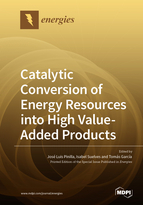Catalytic Conversion of Energy Resources into High Value-Added Products
A special issue of Energies (ISSN 1996-1073). This special issue belongs to the section "A4: Bio-Energy".
Deadline for manuscript submissions: closed (30 June 2020) | Viewed by 24075
Special Issue Editors
Interests: hydrogen; carbon-based catalysts; bio-oils; biomass; hydrogenation catalysts; catalytic methane decomposition; biomass conversion into platform molecules
Special Issues, Collections and Topics in MDPI journals
Interests: production of H2; catalytic methane decomposition; nanocarbons; biomass conversion; carbon-based catalysts; bio-oils
Special Issues, Collections and Topics in MDPI journals
Interests: biomass; biofuels; catalytic pyrolysis; catalytic cracking; zeolites; metal oxides
Special Issues, Collections and Topics in MDPI journals
Special Issue Information
Dear Colleagues,
Developing active, selective and energy efficient heterogeneous catalytic processes is of paramount importance for the production of high-value-added products from energy resources in a more sustainable manner. In this Special Issue of Energies, we invite authors to submit original communications, articles and reviews on the application of heterogeneous catalysis in the conversion of energy resources. The overriding aim of this Special Issue is to provide a platform for researchers to present their latest progress in the development of cleaner, more efficient processes for the conversion of these feedstocks into valuable fuels, chemicals and energy. These catalytic processes include, but are not limited to, the conversion of natural gas, solid fuels (coal, biomass) and heavy liquids (petroleum vacuum residues, bio-oils). The issue will be focus mainly on the application of conventional catalysts based on zeolites, carbon-based materials and mesoporous metal oxides and relatively less exploited catalysts based on transition metal phosphide, nitrides and carbide, ionic liquids as well as atomically dispersed catalysts, with different reactions such as reforming, hydrogenation, cracking and selective oxidation.
Dr. José Luis Pinilla
Dr. Isabel Suelves
Dr. Tomás García
Guest Editors
Manuscript Submission Information
Manuscripts should be submitted online at www.mdpi.com by registering and logging in to this website. Once you are registered, click here to go to the submission form. Manuscripts can be submitted until the deadline. All submissions that pass pre-check are peer-reviewed. Accepted papers will be published continuously in the journal (as soon as accepted) and will be listed together on the special issue website. Research articles, review articles as well as short communications are invited. For planned papers, a title and short abstract (about 100 words) can be sent to the Editorial Office for announcement on this website.
Submitted manuscripts should not have been published previously, nor be under consideration for publication elsewhere (except conference proceedings papers). All manuscripts are thoroughly refereed through a single-blind peer-review process. A guide for authors and other relevant information for submission of manuscripts is available on the Instructions for Authors page. Energies is an international peer-reviewed open access semimonthly journal published by MDPI.
Please visit the Instructions for Authors page before submitting a manuscript. The Article Processing Charge (APC) for publication in this open access journal is 2600 CHF (Swiss Francs). Submitted papers should be well formatted and use good English. Authors may use MDPI's English editing service prior to publication or during author revisions.
Keywords
- heterogeneous catalysis
- coal
- biomass
- bio-oil
- heavy oil
- syn gas
- biofuel
- energy
- reforming
- cracking
- hydrogenation
- selective oxidation
- catalytic pyrolysis
- hydrodeoxygenation








